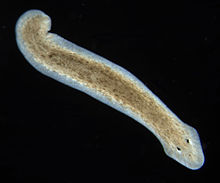- Dugesia
-
For the plant, see Dugesia (plant).
Dugesia 
Dugesia subtentaculata Scientific classification Kingdom: Animalia Phylum: Platyhelminthes Class: Turbellaria Order: Tricladida Suborder: Continenticola
Carranza et al., 1998[1]Family: Dugesiidae Genus: Dugesia
Girard, 1850[2]Species See text
Dugesia is a genus of dugesiid flatworms containing some common representatives of the class Turbellaria. These common flatworms are found in freshwater habitats. Their digestion tract consists of a central tubular pharynx. Each branch consists of ceca, which delivers the nutrients to the body. This worm has a sac digestive plan, that is, it does not have a separate opening for waste excretion.[3]
Planarians have ocelli (eye spots) that detect the amount of light in the nearby environment, and auricles (ear-like flaps) that detect the intensity of water current. They are hermaphrodites, and some of them reproduce by parthenogenesis.[4]
Phylogeny and taxonomy
Dugesia species have not enough morphological characters to find out which are the relationships between them. Furthermore, those available use to contradict each other. Dugesia species are identified by the combination of diagnostic characters instead of different apomorphies. Over 70 species within Dugesia genus have been described.[5]
- D. aenigma
- D. aethiopica
- D. andamanensis
- D. annandalei
- D. arcadia
- D. ariadnae
- D. artesiana
- D. astrocheta
- D. austroasiatica
- D. bactriana
- D. bakurianica
- D. batuensis
- D. benazzii
- D. bengalensis
- D. biblica
- D. borneana
- D. brigantii
- D. burmaensis
- D. capensis
- D. colapha
- D. congolensis
- D. cretica
- D. damoae
- D. debeauchampi
- D. deharvengi
- D. didiaphragma
- D. ectophysa
- D. elegans
- D. etrusca
- D. golanica
- D. gonocephala
- D. hepta
- D. hymanae
- D. ilvana
- D. indica
- D. indonesiana
- D. iranica
- D. izuensis
- D. japonica
- D. krishnaswamyi
- D. lamottei
- D. lanzai
- D. leclerci
- D. leporii
- D. libanica
- D. liguriensis
- D. lindbergi
- D. machadoi
- D. maghrebiana
- D. malickyi
- D. mertoni
- D. milloti
- D. minotauros
- D. mirabilis
- D. monomyoda
- D. myopa
- D. nansheae
- D. neumanni
- D. notogaea
- D. novaguineana
- D. praecaucasica
- D. ryukyuensis
- D. sagitta
- D. salina
- D. siamana
- D. sicula
- D. subtentaculata
- D. sudanica
- D. tamilensis
- D. transcaucasica
- D. uenorum
- D. vestibularis
References
- ^ Carranza S., Littlewood D. T., Clough K. A., Ruiz-Trillo I., Baguñà J. & Riutort M. (1998). "A robust molecular phylogeny of the Tricladida (Platyhelminthes: Seriata) with a discussion on morphological synapomorphies". Proceedings of the Royal Society B: Biological Sciences 265(1396): 631-640. PMC PMC1689013.
- ^ Girard (1850). Proc. Boston Soc. Nat. Hist. 3(1851): 265.
- ^ Gilbertson L. (1999). Zoology Lab Manual. McGraw Hill Companies, New York; ISBN 0-07-237716-X (fourth edition, 1999).
- ^ Benazzi Lentati G. (1966). "Amphimixis and pseudogamy in fresh-water triclads: Experimental reconstitution of polyploid pseudogamic biotypes". Chromosoma 20: 1-14.
- ^ Sluys R., Kawakatsu M. & Winsor L. (1998). "The genus Dugesia in Australia, with its phylogenetic analysis and historical biogeography (Platyhelminthes, Tricladida, Dugesiidae)". Zoologica Scripta 27: 273-289. doi:10.1111/j.1463-6409.1998.tb00461.x.
External links
- "Dugesia" (in english) (HTML) Encyclopedia of Life http://www.eol.org/pages/51564. Retrieved 23-04-2011
- Nogi T., Zhang D., Chan J. D. & Marchant J. S. (2009). "A Novel Biological Activity of Praziquantel Requiring Voltage-Operated Ca2+ Channel β Subunits: Subversion of Flatworm Regenerative Polarity". PLoS Neglected Tropical Diseases 3(6): e464. doi:10.1371/journal.pntd.0000464.

This flatworm- (or platyhelminth-) related article is a stub. You can help Wikipedia by expanding it.
